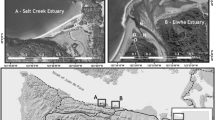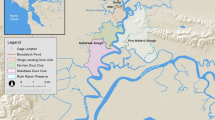Abstract
Estuaries are among the most productive ecosystems in the world and provide important rearing environments for a variety of fish species. Though generally considered important transitional habitats for smolting salmon, little is known about the role that estuaries serve for rearing and the environmental conditions important for salmon. We illustrate how juvenile coho salmon Oncorhynchus kisutch use a glacial river-fed estuary based on examination of spatial and seasonal variability in patterns of abundance, fish size, age structure, condition, and local habitat use. Fish abundance was greater in deeper channels with cooler and less variable temperatures, and these habitats were consistently occupied throughout the season. Variability in channel depth and water temperature was negatively associated with fish abundance. Fish size was negatively related to site distance from the upper extent of the tidal influence, while fish condition did not relate to channel location within the estuary ecotone. Our work demonstrates the potential this glacially-fed estuary serves as both transitional and rearing habitat for juvenile coho salmon during smolt emigration to the ocean, and patterns of fish distribution within the estuary correspond to environmental conditions.




Similar content being viewed by others
References
ADEC (Alaska Department of Environmental Conservation) (2011) Water Quality Standards report no. 18 AAC 70. Anchorage, Alaska. http://dec.alaska.gov/water/wqsar/wqs/pdfs/18_AAC_70_as_Amended_Through_May_26_2011.pdf Accessed 10 June 2012
Bailey RE, Irvine JR, Dalziel FC, Nelson TC (1998) Evaluations of visible implant fluorescent tags for marking coho salmon smolts. N Am J Fish Manag 18:191–196
Beamish RJ, Mahnken C, Neville CM (1997) Hatchery and wild production of Pacific salmon in relation to large-scale natural shifts in the productivity of the marine environment. ICES J Mar Sci 54:1200–1215
Beamish RJ, Mahnken C (2001) A critical size and period hypothesis to explain natural regulation of salmon abundance and the linkage to climate and climate change. Prog Oceanogr 49:423–437
Beamish RJ, Mahnken C, Neville CM (2004) Evidence that reduced early marine growth is associated with lower marine survival of coho salmon. Trans Am Fish Soc 133:26–33
Beamish RJ, Sweeting RM, Lange KL, Neville CM (2008) Changes in the population ecology of hatchery and wild coho salmon in the Strait of Georgia. Trans Am Fish Soc 137:503–520
Bohlin T, Dellafors C, Faremo U (1993) Optimal time and size for smolt migration in wild sea trout Salmo trutta. Can J Fish Aquat Sci 50:224–232
Bottom DL, Jones KK, Cornwell TJ, Gray A, Simenstad C (2005) Patterns of Chinook salmon migration and residency in the Salmon River estuary (Oregon). Estuar Coast Shelf Sci 64:79–93
Bryant MD (2009) Global climate change and potential effects on Pacific salmonids in freshwater ecosystems of southeast Alaska. Clim Change 95:169–193
Campana SE, Neilson JD (1985) Microstructure of fish otoliths. Can J Fish Aquat Sci 42:1014–1032
Chittenden CM, Sura S, Butterworth KG, Cubitt KF, Plantalech Manela N, Balfry S, Oakland F, McKinley RS (2008) Riverine, estuarine and marine migratory behaviour and physiology of wild and hatchery-reared coho salmon Oncorhynchus kisutch (Walbaum) smolts descending the Campbell River, BC, Canada. J Fish Biol 72:614–628
Durbin J, Watson GS (1950) Testing for serial correlation in least squares regression, I. Biometrika 37:409–428
Durbin J, Watson GS (1951) Testing for serial correlation in least squares regression, II. Biometrika 38:159–179
Ebersole JL, Colvin ME (2009) Modeling stream network-scale variation in coho salmon overwinter survival and smolt size. Trans Am Fish Soc 138:564–580
Gaines PC, Martin CD (2004) Feasibility of dual-darking age-0 Chinook salmon for mark–recapture Studies. N Am J Fish Manag 24:1456–1459
Gargett AE (1997) The optimal stability ‘window’: a mechanism underlying decadal fluctuations in North Pacific salmon stocks? Fish Oceanogr 6:109–117
Hayes DB, Bence JR, Kwak TJ, Thompson BE (2007) Abundance, biomass, and production. In: Guy CS, Brown ML (eds) Analysis and interpretation of freshwater fisheries data. American Fisheries Society, Bethesda, pp 327–374
Healey MC (1982) Pacific salmon in estuaries: the life support system. In: Kennedy VS (ed) Estuarine Comparisons. Academic Press, New York, pp 315–341
Healey MC (1994) Variation in life history characteristics of Chinook salmon and its relevance to conservation of the Sacramento winter run of Chinook salmon. Conserv Biol 8:876–877
Hering DK, Bottom DL, Prentice EF, Jones KK, Fleming IA (2010) Tidal movements and residency of subyearling Chinook salmon Oncorhynchus tshawytscha in an Oregon salt marsh channel. Can J Fish Aquat Sci 67:524–533
Hilborn R, Quinn TP, Schindler DE, Rogers DE (2003) Biocomplexity and fisheries sustainability. Proc Natl Acad Sci 100:6564–6568
Hillgruber N, Zimmerman CE (2009) Estuarine ecology of juvenile salmon in western Alaska: A review. In: Krueger CC, Zimmerman CE (eds) Pacific salmon: Ecology and management of western Alaska’s populations. American Fisheries Society Symposium 70, Bethesda, pp 183–199
Hinzman LD, Bettez ND, Bolton WR, Chapin FS, Dyurgerov MB, Fastie CL, Griffisth B, Hollister RD, Hope A, Huntington HP, Jensen AM, Jia GJ, Jorgenson T, Kane DL, Klein DR, Kofinas G, Lynch AH, Lloyd AJ, McGuire AD, Nelson FE, Oechel WC, Osterkamp TE, Racine CH, Romanovsky VE, Stone RS, Stow DA, Sturm M, Tweedie CE, Vourlitis GL, Walker MD, Walker DA, Webber PJ, Welker JM, Winker KS, Yoshikawa K (2005) Evidence and implications of recent climate change in Northern Alaska and other Arctic regions. Clim Change 72:251–298
Hoem Neher TD, Rosenberger AE, Zimmerman CE, Walker CM, Baird SJ (2013) Estuarine environments as rearing habitats for juvenile Coho Salmon in contrasting south-central Alaska watersheds. Trans Am Fish Soc 142:1481–1494
Holtby LB, Healey MC (1990) Sex-specific life history tactics and risk-taking in coho salmon. Ecol Appl 71:678–690
Jonas JL, Kraft CE, Margenau TL (1996) Assessment of seasonal changes in energy density and condition in age-0 and age-1 muskellunge. Trans Am Fish Soc 125:203–210
Kaiser MJ, Attrill MJ, Jennings S, Thomas DN, Barnes DKA, Brierley A, Polunin NV, Raffaelli DG, Le PJ, Williams B (2005) Marine ecology. Oxford University Press, New York
Koski KV (2009) The fate of coho salmon nomads: the story of estuarine-rearing strategy promoting resilience. Ecol Soc 14:4, http://www.ecologyandsociety.org/vol14/iss1/art4/
Mann KH, Lazier JRN (2006) Dynamics of marine ecosystems, 3rd edn. Blackwell publishing, Oxford
McMahon TE, Holtby LB (1992) Behaviour, habitat use, and movements of coho salmon Oncorhynchus kisutch smolts during seaward migration. Can J Fish Aquat Sci 49:1478–1485
Miller BA, Sadro S (2003) Residence time and seasonal movements of juvenile coho salmon in the ecotone and lower estuary of Winchester Creek, South Slough, Oregon. Trans Am Fish Soc 132:546–559
Montgomery DA (2003) King of fish: The thousand year run of salmon. Westview Press, Boulder
Pope KL, Kruse CG (2007) Condition. In: Guy CS, Brown ML (eds) Analysis and interpretation of freshwater fisheries data. American Fisheries Society, Bethesda, pp 423–472
Rosenberger AE, Dunham JB (2005) Validation of abundance estimates from mark–recapture and removal techniques for rainbow trout captured by electrofishing in small streams. N Am J Fish Manag 25:1395–1410
Schaffer WM (2004) Life histories, evolution, and salmonids. In: Hendry AP, Stearns SC (eds) Evolution illuminated. Oxford University Press, Oxford, pp 21–51
Schindler DE, Hilborn R, Chasco B, Boatright C, Quinn TP, Rogers LA, Webster MS (2010) Population diversity and the portfolio effect in an exploited species. Nature 465:609–612
Shaffer JA, Beirne M, Ritchie T, Paradis R, Barry D, Crain P (2009) Fish habitat use response to anthropogenic induced changes of physical processes in the Elwha estuary, Washington, USA. Hydrobiologia 636:179–190
Stearns SC (1976) Life-history tactics: a review of the ideas. Q Rev Biol 51:3–47
Sutton SG, Bult TP, Haedrich RL (2000) Relationships among fat weight, body weight, water weight, and condition factors in wild Atlantic salmon parr. Trans Am Fish Soc 129:527–538
USEPA (U.S. Environmental Protection Agency) (2012) Primer for identifying cold-water refuges to protect and restore thermal diversity in riverine landscapes. Department of the Interior, Seattle, WA. http://www.epa.gov/region10/pdf/water/torgersen_etal_2012_cold_water_refuges.pdf. Accessed 15 June 2012
Webster SJ, Dill LM, Korstrom JS (2007) The effects of depth and salinity on juvenile Chinook salmon Oncorhynchus tshawytscha (Walbaum) habitat choice in an artificial estuary. J Fish Biol 71:842–851
Acknowledgments
We wish to acknowledge and thank Leon Shaul and the two anonymous reviewers who provided reviews that greatly improved this manuscript. Much appreciation is expressed to University of Alaska School of Fisheries professors Franz Mueter and Megan McPhee for their review and guidance. The Kachemak Bay National Estuarine Research Reserve provided much needed staff support, facilities, and equipment. Thank you to Angela Doroff, Ori Badajos, and Jasmine Maurer for providing assistance with equipment, data management, and editorial review. Volunteers Janet Fink, Jason Neher, Russ Walker, and Michelle Gutsch provided invaluable assistance with fieldwork. This research was conducted in the National Estuarine Research Reserve System under an award from the Estuarine Reserves Division, Office of Ocean and Coastal Resource Management, National Ocean Service, National Oceanic and Atmospheric Administration. Additional funding came from State Wildlife Grants to KBRR, the University of Alaska Fairbanks, and Alaska Experimental Program to Stimulate Competitive Research. All work was completed under the University of Alaska Institutional Animal Care and Use Committee approved sampling plans. Use of trade, product, or firm names is for descriptive purposes only and does not imply endorsement by the U.S. Government.
Author information
Authors and Affiliations
Corresponding author
Rights and permissions
About this article
Cite this article
Neher, T.D.H., Rosenberger, A.E., Zimmerman, C.E. et al. Use of glacier river-fed estuary channels by juvenile Coho Salmon: transitional or rearing habitats?. Environ Biol Fish 97, 839–850 (2014). https://doi.org/10.1007/s10641-013-0183-x
Received:
Accepted:
Published:
Issue Date:
DOI: https://doi.org/10.1007/s10641-013-0183-x




